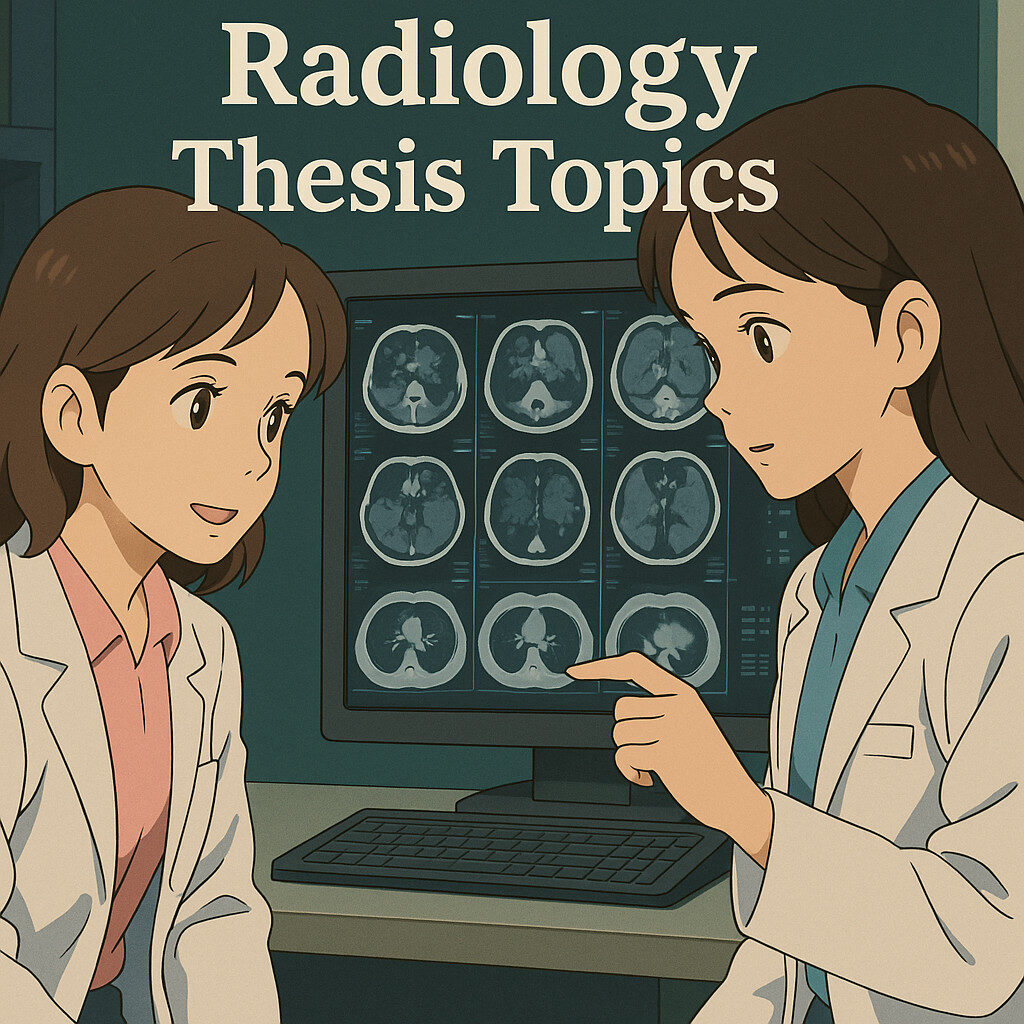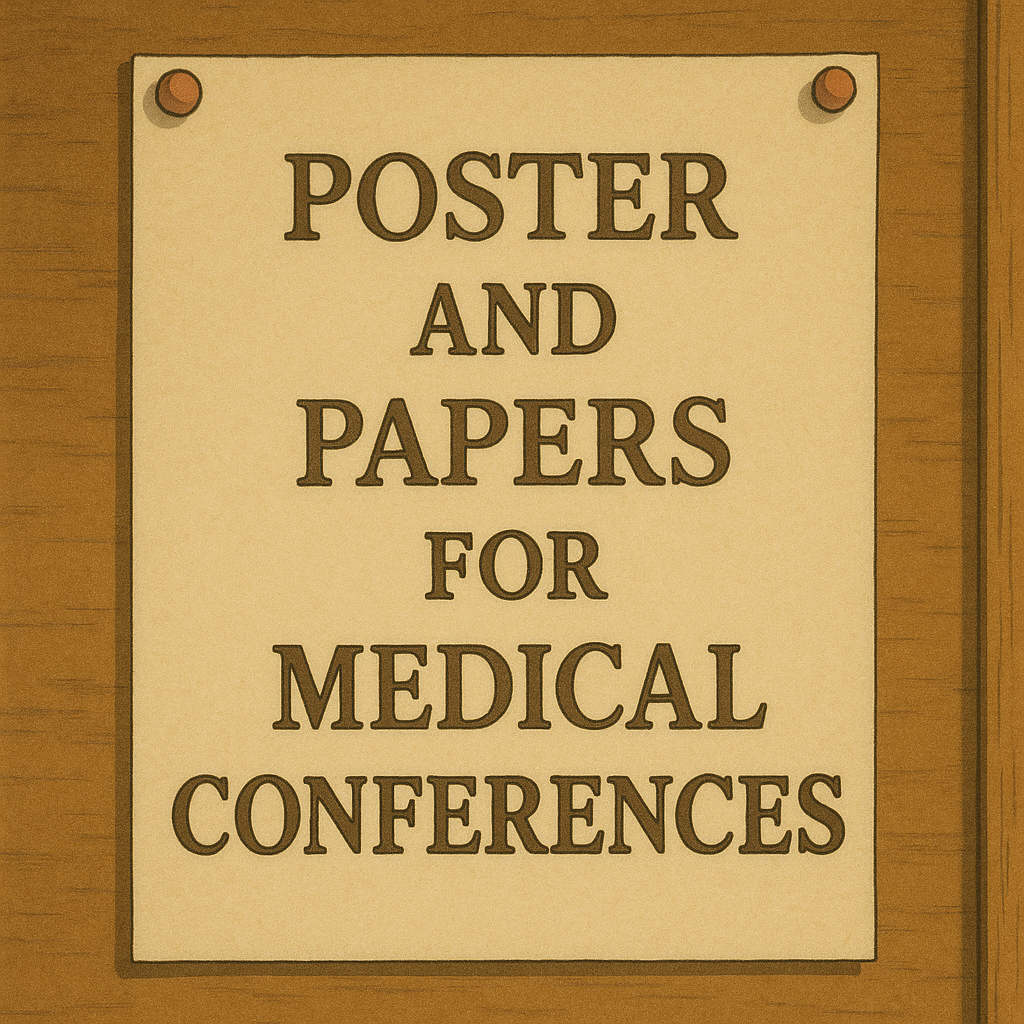RADIOLOGY THESIS TOPICS

RADIOLOGY THESIS TOPICS
Selecting the right radiology thesis topics is vital for conducting impactful research in diagnostic and interventional imaging. Prominent radiology thesis topics cover areas like musculoskeletal imaging, neuroradiology, breast imaging, pediatric radiology, cardiac imaging, oncologic imaging, and interventional radiology techniques. By focusing on evidence-based radiology thesis topics, researchers ensure that their work is clinically relevant and technologically up-to-date.
A well-documented thesis on progressive radiology thesis topics holds great potential for publication in reputed medical journals, a requirement crucial for academic promotions and appointments in medical institutions. Emphasizing innovative and relevant radiology thesis topics enhances clinical accuracy, fosters academic excellence, and contributes to the advancement of medical imaging as a cornerstone of modern healthcare.
1. Diagnostic Radiology Modalities
A prospective cross-sectional study comparing slice sensitivity profiles and lesion detectability of 64-slice versus 128-slice CT scanners in pulmonary nodule evaluation
A case-control analysis of lesion conspicuity in breast MRI using 1.5T versus 3T scanners: contrast-to-noise ratio and diagnostic accuracy
A retrospective cohort study of interobserver variability in PI-RADS scoring for prostate MRI across radiologists with different experience levels
An in vitro phantom study evaluating spatial resolution and low-contrast detectability of digital radiography systems using anthropomorphic phantoms
A cross-sectional evaluation of automated versus manual measurement of carotid intima-media thickness on ultrasound: reproducibility and time efficiency
A methodological validation of dual-energy CT iodine mapping for characterization of renal lesions compared to standard single-energy CT
A prospective observational study of radiation dose and image quality trade-offs in pediatric abdominal CT using iterative reconstruction algorithms
A randomized crossover trial of patient positioning (supine versus prone) impact on artifact reduction in abdominal MRI
A systematic review and meta-analysis of accuracy and pooled sensitivity of contrast-enhanced ultrasound in focal liver lesion characterization
A narrative review of advances in artifact reduction techniques in MRI: parallel imaging and compressed sensing
2. Interventional Radiology
A prospective cohort study of technical success and complications in ultrasound-guided percutaneous liver biopsy versus CT-guided biopsy
A randomized controlled trial of drug-eluting versus bare-metal balloon angioplasty for angioplasty of dysfunctional dialysis fistulas: patency and cumulative access survival
A retrospective analysis of radiation exposure and procedural time comparing fluoroscopy-guided versus ultrasound-guided central venous catheter placement
An in vitro flow phantoms study measuring embolic agent delivery precision using cone-beam CT guidance in uterine fibroid embolization simulation
A case-control study of pain reduction and opioid requirement comparing microwave versus radiofrequency ablation in hepatic tumor treatment
A methodological validation of real-time MRI guidance for targeted prostate biopsy compared to cognitive MRI-ultrasound fusion
A cross-sectional survey of patient satisfaction and quality-of-life improvements following CT-guided percutaneous vertebroplasty in osteoporotic vertebral fractures
A systematic review and meta-analysis of safety and efficacy of endovascular thrombectomy techniques in acute ischemic stroke
An in silico simulation of contrast kinetics to optimize injection protocols for peripheral angiography in diabetic foot evaluation
A narrative review of emerging interventional radiology techniques in peripheral arterial disease: drug-coated balloons and atherectomy
3. Neuroradiology
A prospective observational study of diffusion tensor imaging metrics in acute ischemic stroke for predicting functional outcome at 3 months
A cross-sectional comparison of arterial spin labeling versus dynamic susceptibility contrast MRI for cerebral perfusion assessment in dementia patients
A retrospective cohort analysis of CT perfusion thresholds for core infarct estimation in anterior versus posterior circulation strokes
An in vitro phantom study validating volumetric accuracy of automated brain tumor segmentation algorithms on MRI
A case-control evaluation of susceptibility-weighted imaging sensitivity in detecting cerebral microbleeds in traumatic brain injury
A methodological validation of 7T MRI versus 3T MRI for visualization of hippocampal subfields in temporal lobe epilepsy
A systematic review and meta-analysis of perfusion CT parameters as predictors of hemorrhagic transformation post-thrombolysis
An in silico modeling study of cerebrospinal fluid flow dynamics in aqueductal stenosis using phase-contrast MRI data
A prospective randomized trial of gadolinium-based contrast agents: macrocyclic versus linear chelates on signal-to-noise ratio and safety markers
A narrative review of spinal cord diffusion imaging advances in diagnosis of multiple sclerosis
4. Musculoskeletal Radiology
A prospective cohort study of T2 mapping and delayed gadolinium-enhanced MRI of cartilage (dGEMRIC) for early detection of osteoarthritis in asymptomatic individuals
A cross-sectional ultrasound elastography evaluation of Achilles tendon stiffness in athletes with versus without tendinopathy
A retrospective analysis of CT-based 3D morphological parameters predictive of femoroacetabular impingement severity
An in vitro biomechanical phantom study assessing the accuracy of BMD estimation by quantitative CT versus DXA in vertebral bodies
A case-control study of MRI marrow edema patterns in stress fractures versus bone tumors: interobserver agreement and diagnostic features
A methodological validation of ultra-high-frequency ultrasound for evaluation of superficial hand and wrist structures compared to MRI
A systematic review and meta-analysis of whole-body MRI for detection of skeletal metastases in high-risk cancer patients
An in silico finite-element analysis of stress distribution in osteochondral grafts for knee cartilage repair
A prospective randomized trial comparing single-energy versus dual-energy CT in detection of gouty tophi deposits
A narrative review of advances in molecular imaging of bone turnover using novel PET tracers
5. Pediatric Radiology
A prospective cohort study of automated airway measurement by 3D MRI versus manual measurement in pediatric patients with suspected tracheomalacia
A cross-sectional evaluation of low-dose CT protocols for pediatric chest imaging: image quality and diagnostic confidence
A retrospective cohort analysis of MRI findings and developmental outcomes in preterm infants with periventricular leukomalacia
An in vitro phantom study validating pediatric-specific dosimetry for fluoroscopy-guided voiding cystourethrograms
A case-control study of ultrasound versus MRI accuracy in detecting developmental dysplasia of the hip in infants
A methodological validation of rapid-sequence MRI for evaluation of pediatric brain tumors without sedation
A systematic review of ultrasound shear-wave elastography in pediatric liver fibrosis assessment
An in silico simulation of radiation scatter in pediatric abdominal fluoroscopy: optimization of shielding protocols
A prospective pilot study of contrast-enhanced ultrasound for evaluation of pediatric focal liver lesions
A narrative review of motion-correction techniques in fetal MRI
6. Cardiothoracic Radiology
A prospective observational study of coronary CT angiography plaque characterization using dual-energy CT virtual monochromatic imaging
A cross-sectional analysis of right ventricular strain by feature-tracking MRI in patients with pulmonary hypertension versus controls
A randomized controlled trial comparing low-dose versus standard-dose chest CT protocols in COVID-19 pneumonia: diagnostic accuracy and radiation dose
An in vitro phantom study evaluating calibration and reproducibility of lung nodule volumetry software across CT vendors
A case-control study of perfusion deficits on dual-energy CT pulmonary angiography in chronic thromboembolic pulmonary hypertension
A methodological validation of non-contrast MRI-based pulmonary blood flow measurement using phase-contrast techniques
A systematic review and meta-analysis of CT-based lung cancer screening: dose, detection rates, and overdiagnosis
An in silico computational fluid dynamics study of aortic flow patterns in bicuspid versus tricuspid aortic valves based on MRI data
A prospective cohort study of dynamic chest MRI for functional assessment of diaphragmatic paralysis
A narrative review of emerging radiomics approaches in prognostication of interstitial lung disease
7. Abdominal Imaging
A prospective cohort study of MRI proton density fat fraction (PDFF) versus MR spectroscopy for quantification of hepatic steatosis in NAFLD patients
A cross-sectional evaluation of diffusion-weighted MRI apparent diffusion coefficient values for differentiation of benign versus malignant pancreatic lesions
A retrospective cohort analysis of CT perfusion parameters predicting response to transarterial chemoembolization in hepatocellular carcinoma
An in vitro phantom study comparing lesion contrast detectability in various MRI liver sequences (T1, T2, DWI)
A case-control study of radiomic texture features on multiphase CT for characterization of adrenal incidentalomas
A methodological validation of automated volumetric assessment of spleen size on CT versus manual measurements
A systematic review and meta-analysis of CT enterography accuracy in small bowel Crohn’s disease detection
An in silico fluid dynamics modeling of bile duct flow in primary sclerosing cholangitis based on MRCP data
A prospective trial comparing gadoxetate disodium–enhanced MRI versus extracellular contrast MRI for detection of focal liver lesions
A narrative review of multiparametric MRI protocols in assessment of renal function and fibrosis
8. Breast Imaging & Mammography
A prospective screening study comparing digital breast tomosynthesis versus full-field digital mammography in detection of small breast cancers
A cross-sectional analysis of elastography metrics on ultrasound for differentiation of benign versus malignant breast lesions
A retrospective cohort evaluation of MRI background parenchymal enhancement and its correlation with breast cancer risk factors
An in vitro phantom study testing calibration and accuracy of automated breast density software across mammography units
A case-control study of contrast-enhanced spectral mammography sensitivity and specificity versus DM+DBT combinations
A methodological validation of abbreviated breast MRI protocols for screening high-risk women: acquisition time and diagnostic accuracy
A systematic review and meta-analysis of serum and imaging biomarkers in predicting pathologic complete response after neoadjuvant therapy
An in silico modeling study of radiation dose distribution in breast tissue with varying glandular compositions during mammography
A pilot prospective study of automated AI-based CAD tools on digital mammography diagnostic performance
A narrative review of emerging molecular breast imaging techniques with novel radiotracers
9. Nuclear Medicine & PET-CT
A prospective cohort study of 18F-FDG PET/CT standardized uptake values as predictors of treatment response in diffuse large B-cell lymphoma
A randomized crossover trial of PET/MRI versus PET/CT in staging of pediatric oncology patients: diagnostic accuracy and radiation dose
A cross-sectional evaluation of myocardial perfusion quantification by 99mTc-sestamibi SPECT versus PET using rubidium-82
An in vitro phantom study of PET scanner calibration for quantitative accuracy in brain amyloid imaging with 18F-Florbetapir
A case-control study of somatostatin receptor PET tracers (68Ga-DOTATATE) uptake in neuroendocrine tumor patients versus controls
A methodological validation of SUV normalization methods (lean body mass vs total body) in oncology PET studies
A systematic review and meta-analysis of PSMA PET/CT accuracy in detection of prostate cancer recurrence
An in silico compartmental modeling of tracer kinetics for dynamic PET studies in neuroinflammation imaging
A prospective trial comparing dosimetry and image quality of 90Y microsphere SIRT planning with 99mTc-MAA versus PET surrogate tracers
A narrative review of theranostic applications in nuclear medicine: from diagnosis to radionuclide therapy
10. Recent Advances in Radiology
A scoping review of artificial intelligence–driven automated lesion detection and characterization across multiple imaging modalities
A prospective pilot study of ultrafast MRI protocols (<5 minutes) for whole-body oncologic screening: feasibility and diagnostic yield
A methodological assessment of photon-counting CT systems versus energy-integrating detectors: contrast resolution and dose reduction
An in vitro validation of magneto-motive ultrasound for molecular imaging of targeted nanoparticles in phantom and ex vivo tissues
An in silico multi-omics integration framework for radiogenomic correlation in glioblastoma: imaging biomarkers and genetic profiles
A systematic review and meta-analysis of focused ultrasound blood–brain barrier disruption techniques for targeted drug delivery
A narrative review of wearable imaging devices (capsule endoscopy, portable ultrasound) and their clinical applications
A pilot clinical trial of real-time MRI-guided adaptive radiotherapy planning in head and neck cancer patients
A retrospective data-mining analysis of PACS metadata to predict radiology workflow bottlenecks and optimize scheduling
A narrative review of quantum sensing and advanced detector materials for next-generation medical imaging



